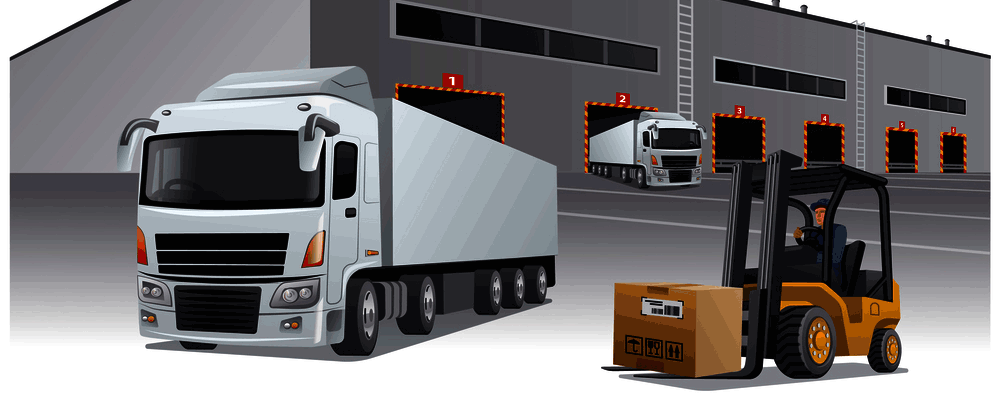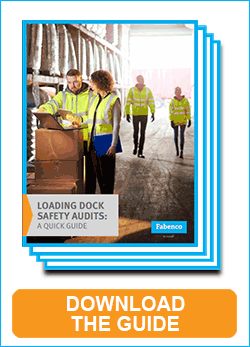
Loading dock safety is always a concern in any commercial facility. In the best of times, heavy machinery, elevated surfaces, and potentially dim lighting conditions pose fall hazards to your employees that must be mitigated by safety gates, other fall protection equipment, and more. However, with the ongoing threat of COVID-19, workplaces everywhere are facing new safety challenges, and the loading dock is no exception.
OSHA recently released an alert about the importance of protecting loading dock workers during the pandemic. As the safety focus around the world has shifted toward social distancing and regular cleaning and disinfecting, you can’t lose sight of fall protection. On the loading dock, this requires a careful balance.
COVID-19 Guidelines for Loading Dock Safety
In the alert, OSHA outlines the following tips for stockroom and loading dock workers during the pandemic:
- Maintain a distance of at least six feet between yourself and other people
- Stock shelves when the store is closed, during slow periods, or with protective barriers between employees and customers
- Limit the number of people allowed in the store at one time
- Coordinate with delivery drivers to limit contact with employees
- Wear masks
- Discourage sharing of equipment
- Encourage frequent hand-washing or use of hand sanitizer containing at least 60 percent alcohol
- Empower employees to report safety concerns
Furthermore, high traffic areas should be regularly cleaned and disinfected with products that have been approved to reduce or stop the spread of the virus. As always, employees who don’t feel well or who have been in contact with someone who has COVID-19 should stay home. Many businesses conduct mandatory temperature checks when employees arrive, and anyone with a high temperature is not permitted to work that day.
The Challenges of COVID-19 Safety Measures on the Loading Dock
It’s one thing to maintain six feet of distance in an office – on a dock, it’s another matter. Small spaces can make it difficult to maintain the safe distance; as it pushes an employee away from potential infection, it pushes them toward the leading edge. Wearing masks can make it more difficult to communicate, it can muffle the voice in a noisy environment, and can limit peripheral and downward vision, a huge concern around leading edges.
Employees are regularly touching items and handing them off to others, and they may be regularly coming in contact with customers and delivery drivers. Avoiding that contact can disrupt the workflow they’re accustomed to, and it could take time for new methods to become habits.
An illness or suspected illness can leave the team short-handed. Struggling to fill the gaps can be distracting or physically exhausting for the employees who are still at work, and it may put them in the position of choosing urgency or efficiency over safety. There’s also the stress of the coronavirus cloud hanging over everyone’s heads. Employees, more than ever, are concerned about their families, their health, and their job security. That stress can introduce a vicious cycle of distraction, sleeplessness, and poor health that can impact the work day.
Maintain Proper Fall Protection
All your old loading dock safety measures must coexist with the new coronavirus safety measures, which may introduce the need for new fall protection equipment like a loading dock safety gate, and more. It may help to conduct an audit of your loading dock area:
- Have all employees been thoroughly trained in safety practices and protocols, including the new COVID-19 guidelines? Have long-time employees gone through a refresher course?
- Is the dock well-lit? If you’ve spread out deliveries or added shifts, you may have employees working through the night. Ensure the lighting is still sufficient, no matter the time of day.
- Is your dock clean? Today, that means regular disinfecting as well as ensuring there is no clutter, debris, or slippery areas. With the use of liquid disinfectants, you may need to allow for drying time before work can resume.
- Are hazards and safety exits clearly marked? Posters outlining best practices regarding fall safety as well as virus safety can be posted.
- Is there a first aid kit, fire extinguisher, and AED close by? Is the kit well-stocked; are the AED’s batteries working?
- Are employees verifying trailers are secured to the docks before unloading?
- Are vehicles turned off and equipment locked up when not in use?
- Are doors closed and locked when the dock is not in use, or are you using a loading dock safety gate?
- Do you have appropriate fall protection measures in place?

As always, it’s important to remember that OSHA guidelines represent the minimum precautions. You may identify the need for additional safety measures, especially with the COVID-19 safety considerations.
If you need to keep the dock door open for ventilation (in light of COVID-19, the CDC recommends increasing “…circulation of outdoor air as much as possible by opening windows and doors if possible, and using fans”), you should definitely consider installing a loading dock safety gate. They’re easy to install and easy to open, allowing you to improve your safety without sacrificing productivity. That open door also allows you to see trucks arriving, so you’re ready to unload with less delay.
All safety gates, guardrails, and other fall protection equipment must be OSHA-compliant. The easiest way to ensure that is to work with a supplier that guarantees it. We handle compliance for you, so you don’t have to measure, double-check, and research it yourself. With proper installation and use, the right safety equipment goes a long way in creating an incident-free workplace during the time of COVID-19 and far beyond.




